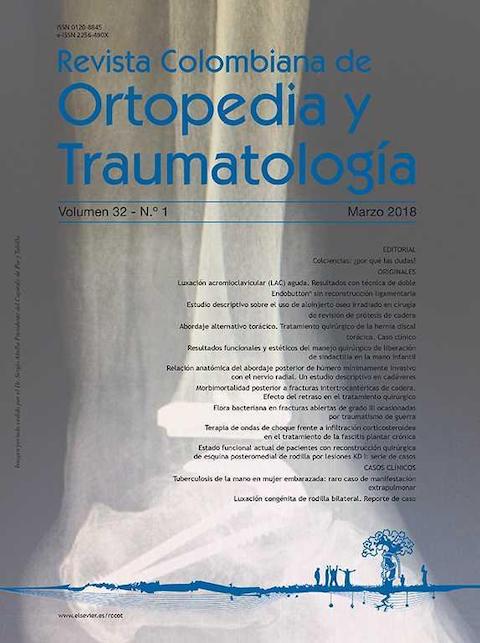Estudio descriptivo sobre el uso de aloinjerto óseo irradiado en cirugía de revisión de prótesis de cadera
DOI:
https://doi.org/10.1016/j.rccot.2017.08.005Palabras clave:
artroplastia de cadera, revisión, aloinjerto óseo irradiadoResumen
Introducción: El uso de aloinjerto óseo irradiado en las revisiones de cadera es controvertido por las alteraciones que genera este tratamiento en el hueso. Se realizó una evaluación de una serie consecutiva de pacientes con revisión en que se utilizó este tipo de tejido.
Materiales y métodos: Se realizó una evaluación retrospectiva de una serie de casos consecutivos (2005-2013) de 54 pacientes (55 caderas) intervenidos por un solo cirujano.
Resultados: Dos pacientes requirieron una nueva revisión y tres pacientes terminaron sin prótesis por infección profunda. Se realizó el seguimiento de 39 caderas, en el cual se destaca una mejoría de la puntuación de Merle d’Aubigné-Postel, con un promedio de 9 a 14; se encontró que 11 de los 27 acetábulos (40,7%) presentaron una migración en algún plano mayor o igual a 5 mm y todos los restantes, menos uno, tuvieron alguna migración. La media de hundimiento del tallo femoral fue 4,9 mm. La incorporación del injerto se constató en el 14,8% (4/27) en el acetábulo y el 50% (8/16) en el fémur.
Discusión: Esta serie muestra excelentes resultados clínicos en general, pero, mientras el injerto irradiado en forma de chapas para el fémur y estructural para el acetábulo tiene buen resultado clínico y radiológico, y un buen índice de incorporación, el tejido que llega en chips para técnica de injerto compactado provoca fallas radiológicas muy frecuentes (con relación a lo publicado) y, a pesar de los buenos resultados clínicos y de la seguridad biológica ofrecida, debe indicarse con precaución y nunca debe ser la primera opción.
Nivel de evidencia clínica: Nivel IV.
Descargas
Referencias bibliográficas
Soderman P, Malchau H, Herberts P. Outcome after total hip arthroplasty: Part I. General health evaluation in relation to definition of failure in the Swedish National Total Hip Arthoplasty register. Acta Orthop Scand. 2000;71:354-9. https://doi.org/10.1080/000164700317393330
Soderman P, Malchau H, Herberts P, Zugner R, Regner H, Garellick G. Outcome after total hip arthroplasty: Part II. Disease-specific follow-up and the Swedish National Total Hip Arthroplasty Register. Acta Orthop Scand. 2001;72:113-9. https://doi.org/10.1080/000164701317323345
Mayle RE Jr, Paprosky WG. Masive bone loose. Allograftprosthetic composite and beyond. J Bone Joint Surg. 2012:61-4, 94-B. A. https://doi.org/10.1302/0301-620X.94B11.30791
http://www.fnr.gub.uy. Fondo Nacional de Recursos de Medicina Altamente Especializada. Fecha de último acceso: 11 de mayo de 2016.
Older J. Charnley low-friction arthroplasty: A worldwide retrospective review at 15 to 20 years. J Arthroplasty. 2002;17:675-80. https://doi.org/10.1054/arth.2002.31973
Vastel L, Meunier A, Siney H, Sedel L, Courpied J. Effect of different sterilization methods on the mechanical properties of human cancellous bone allografts. Biomaterials. 2004;25:2105-10. https://doi.org/10.1016/j.biomaterials.2003.08.067
Roussouly P, Mine C, Petreto E, Gonon G, Fisher LP. Étude de la résistance en flexion et en compression d'os longs irradiés par rayonnement gamma. Rev Chir Orthop. 1988;74 suppl 2:199-202.
Moreau MF, Gallois Y, Basle MF, Chapard D. Gamma irradiation of human bone allograft alters medullary lipids and release toxics compounds for osteoblast-like cells. Biomaterials. 2000;21:369-76. https://doi.org/10.1016/S0142-9612(99)00193-3
Merle d'Aubigné R, Postel M. The classic functional results of hip arthroplasty with acrylic prosthesis. Clin Orthop Relat Res. 2009;467:7-27. https://doi.org/10.1007/s11999-008-0572-1
D'Antonio JA, Capello WN, Borden LS, Bargar WL, Bierbaum BF, Boettcher WG, et al. Classification and management of acetabular abnormalities in total hip arthroplasty. Clin Orthop Relat Res. 1989;243:126-37. https://doi.org/10.1097/00003086-198906000-00019
Paprosky WG, Perona PG, Lawrence JM. Acetabular defect classification and surgical reconstruction in revision arthroplasty. A 6-year follow-up evaluation. J Arthroplasty. 1994;9:33-44. https://doi.org/10.1016/0883-5403(94)90135-X
Gie GA, Linder L, Ling RS, Simon JP, Slooff TJ, Timperley AJ. Impacted cancellous allografts and cement for revision total hip arthroplasty. J Bone Joint Surg Br. 1993;75:14-21. https://doi.org/10.1302/0301-620X.75B1.8421012
Hassaballa M, Mehendale S, Poniatowski S, Kalantzis G, Smith E, Learmonth ID. Subsidence of the stem after impaction bone grafting for revision hip replacement using irradiated bone. J Bone Joint Surg Br. 2009;91-B:37-43. https://doi.org/10.1302/0301-620X.91B1.20376
Deakin DE, Bannister GC. Graft incorporation after acetabular and femoral impaction grafting with washed irradiated allograft and autologous marrow. Arthroplasty. 2007;22:89-94. https://doi.org/10.1016/j.arth.2006.02.162
Harris WH. Allografting in total hip arthroplasty: In adults with severe acetabular deficiency including a surgical technique for bolting the graft to the ilium. Clin Orthop Relat Res. 1982;162:150-64. https://doi.org/10.1097/00003086-198201000-00025
Slooff TJ, Huiskes R, van Horn J, Lemmens AJ. Bone grafting in total hip replacement for acetabular protrusion. Acta Orthop Scand. 1984;55:593-6. https://doi.org/10.3109/17453678408992402
Wilson D, Frei H, Masri BA, Oxland TR, Duncan CP. A biomechanical study comparing cortical onlay allograft struts and plates in the treatment of periprosthetic femoral fractures. Clin Biomech (Bristol, Avon). 2005;20:70-6. https://doi.org/10.1016/j.clinbiomech.2004.08.008
Haddad FS, Duncan CP, Berry DJ, Lewallen DG, Gross AE, Chandler HP. Periprosthetic femoral fractures around well-fixed implants: Use of cortical onlay allografts with or without a plate. J Bone Joint Surg Am. 2002;84-A:945-50. https://doi.org/10.2106/00004623-200206000-00008
Ling RS, Timperley AJ, Linder L. Histology of cancellous impaction grafting in the femur. A case report. J Bone Joint Surg Br. 1993;75:693-6. https://doi.org/10.1302/0301-620X.75B5.8376422
Gross A, Allen G. Revision arthroplasty using allograft bone. AAOS Instr Course Lect. 1993:263-380.
Vargas B, Caton J. Acetabular revision with freeze-dried irradiated and chemically treated allograft: A minimum 5-year follow-up of 17 cases. Int Orthop (SICOT). 2009;33:35-9. https://doi.org/10.1007/s00264-007-0444-4
McNamara S, Deshpande M. Porteous. Impaction grafting of the acetabulum with a mixture of frozen, ground irradiated bone graft and porous synthetic bone substitute (Apapore 60). J Bone Joint Surg Br. 2010;92-B:617-23. https://doi.org/10.1302/0301-620X.92B5.23044
Mehendale S, Learmonth I, Smith E, Suneel NY, Maheshwari R, Hassaballa MA. Use of irradiated bone graft for impaction grafting in acetabular revision surgery: A review of fifty consecutive cases. Hip Int. 2009;19:114-9. https://doi.org/10.1177/112070000901900206
Ochs BG, Schmid U, Rieth J, Ateschrang A, Weise K, Ochs U. A comparison of freeze-dried, irradiated and chemicallytreated allograft vitalized with autologous marrow versus frozen non-irradiated allograft. J Bone Joint Surg Br. 2008;90-B: 1164-71. https://doi.org/10.1302/0301-620X.90B9.20425
Howie DW, Callary SA, McGee MA. Reduced femoral component subsidence with improved impaction grafting at revision hip arthroplasty. Clin Orthop Relat Res. 2010;468: 331-421. https://doi.org/10.1007/s11999-010-1484-4
Buttaro M, Comba F, Pusso R, Piccaluga F. Acetabular revision with metal mesh, impaction bone grafting, and a cemented cup. Clin Orthop Relat Res. 2008;466:2482-90. https://doi.org/10.1007/s11999-008-0442-x
Nusem I, Morgan D. The use of gamma-irradiated proximal femoral allografts for bone stock reconstruction in complex revision hip arthroplasty. Hip Int. 2013;23:451-8. https://doi.org/10.5301/hipint.5000065
Descargas
Publicado
Cómo citar
Número
Sección
Licencia
Derechos de autor 2024 Revista Colombiana de ortopedia y traumatología

Esta obra está bajo una licencia Creative Commons Reconocimiento 3.0 Unported.








